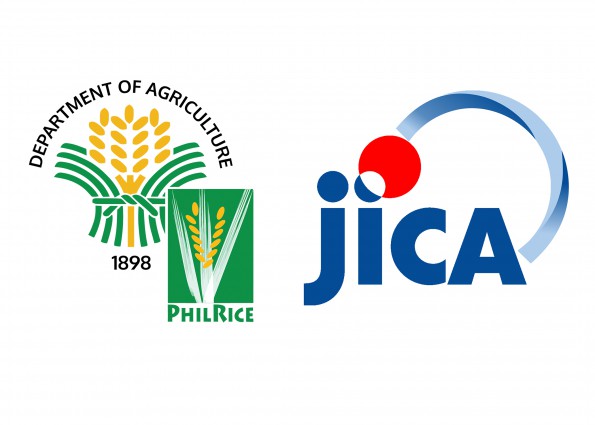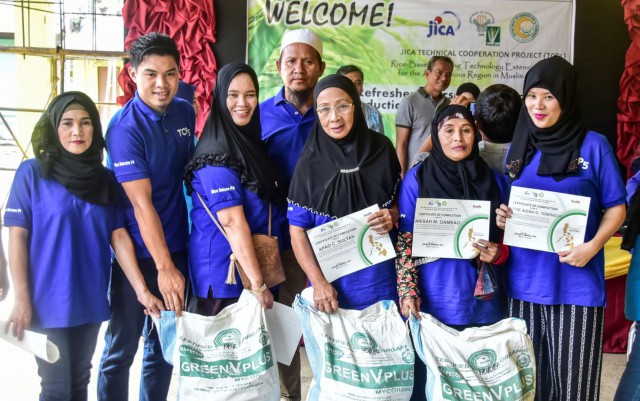
Farmers across the country had benefited from the decades-long cooperation project between Japan International Cooperation Agency (JICA) and Philippine Rice Research Institute (PhilRice).
Through the partnership among Japanese and Filipino experts, extensionists, farmers, and local government units, cold-tolerant rice varieties, labor-saving machines, and rice and rice-based technologies were developed and improved.
Working together
From 1992 to 2010, JICA dispatched 70 experts led by Drs. Hitoshi Takahashi, Norio Nakaya, Moriyuki Shigyo, and Nobuyuki Kabaki trained 64 Filipino researchers/personnel in Japan to enhance their capabilities in implementing research and development projects.
During the Technical Cooperation Projects (TCP 1 and 2), six varieties developed with high-yield and excellent grain qualities: NSIC Rc 104 (PJ2) for cold-elevated areas under medium elevation (<1000 m above sea level); Rc 134 (PJ21), Rc 138 (PJ25), Rc 150 (PJ27), and Rc 216 (PJ33) are early maturing (105 days) suited for direct wet-seeding; and Rc 146 (PJ7) suited for areas with low solar radiation in Caraga region. Machines for land preparation and crop establishment (land leveler, disc side plow, hand tractor-mounted drum seeder) and harvesting (rotary reaper and rice mini-combine harvester), were also developed. Other labor-saving and cost-reducing technologies such as proper amount and timing of fertilizer application, water management in direct seeding were also conducted.
Moreover, the “Development and promotion of location-specific integrated high-yielding rice and rice-based technologies” or TCP 3 led to the adaptation of technologies developed in TCP1-2 in Ilocos Norte, Ilocos Sur, Nueva Ecija, Agusan Del Norte, and Agusan Del Sur.
Under the ARMM-based TCP 4 project, which was implemented with the Department of Agriculture and Fisheries – ARMM, state universities and local government units, around 360 agricultural technicians (ATs) were trained who facilitated the 138 farmers’ field schools (FFS) conducted in Basilan, Sulu, Tawi-Tawi, Maguindanao, and Lanao del Sur. About 3,800 farmers participated in rice farming training while about 4,200 on vegetable production.
To sustain the TCP 4 impacts, TCP 5 was implemented to enhance government’s capacity in delivering agricultural extension services and improving farmers’ adaptation to rice and rice-based technologies. A total of 296 ATs of DAF-ARMM acquired new skills in conducting and facilitating 100 FFS with 3,22 farmer-participants. Further, 74 farmers were selected and trained to become farmer-to-farmer extension workers (FTF-EW) who then trained 721 farmers, while 312 Bangsamoro women learned food preparation and processing. The Rice Crop Manager, a guide on right fertilizer application, was promoted in two Maguindanao sites, resulting in yield increased by more than 1t/ha.
The Japan government begun extending its support to PhilRice in 1990. Under grant-aid assistance program that provided a modern “home” for PhilRice, it funded the construction of research laboratories, development of experimental farm, and procurement of field and laboratory equipment of PhilRice.

Photo by Zenny Awing
Social Impacts
JICA-PhilRice programs resulted in technology adaptation and farmers’ knowledge application.
From simple housewife , Rapia Jumil, became a productive farmer. She earns P7, 000 from vegetables and P15, 000 from fruit trees.
“I am poor with no other means to earn aside from farming. I am thankful that because of the JICA training I’ve attended, I am now more able to support my children,” Rapia shared.
Members of the Moro National Liberation Front (MNLF) also benefited from the project.
Saifon D. Abdulmanan, a high-ranking MNLF official said that TCP 4 gave them food production technology, not money.
“If it were money, we might not have accepted it. Money runs out fast, we cannot fully benefit from it,” Shaifon said.
As an influencer in their community, he was able to encourage more of his neighbors and other MNLF members to continue cultivating their lands.
As both agencies continually to share their expertise and technologies to the ground, more and more Filipinos would experience less worries, just like Saifon and Rafia. -With reports from Mary Grace Nidoy, Jaime Manalo




